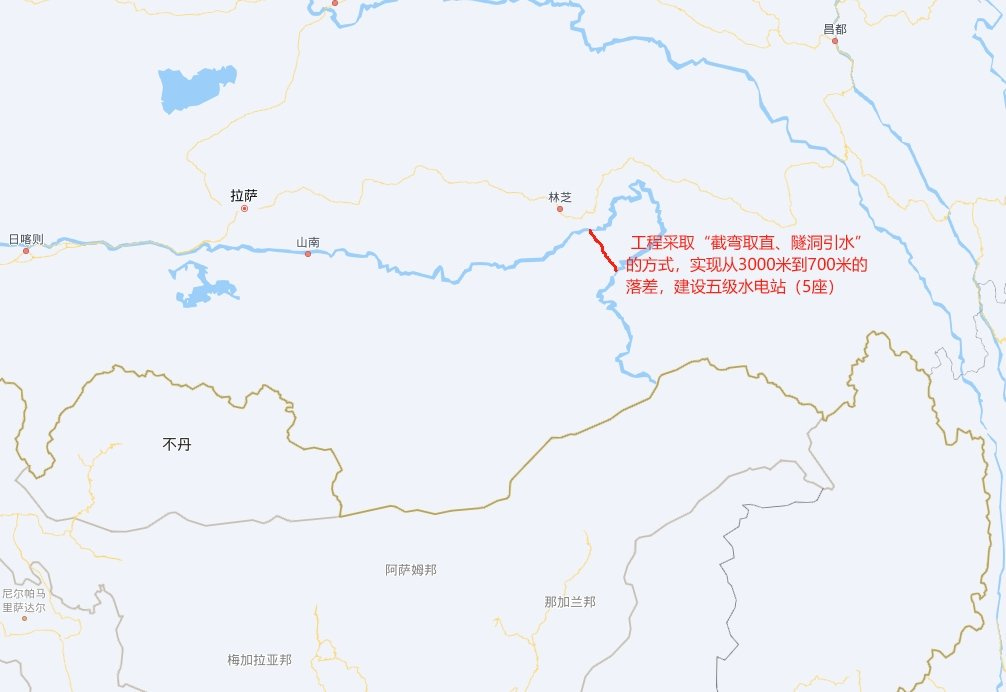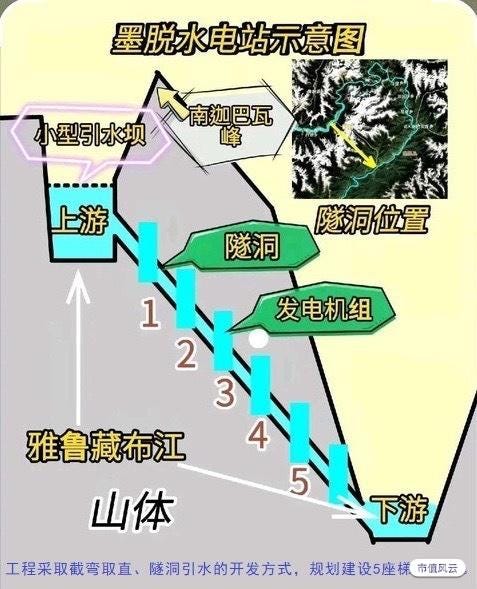China starts building world’s biggest hydropower dam
What's this Yarlung Tsangpo hydropower dam? and why China start building this dam?
China's Premier Li Qiang announced construction had begun on what will be the world's largest hydropower dam, on the eastern rim of the Tibetan Plateau on 21 July, at an estimated cost of at least $170 billion. What's this Yarlung Tsangpo hydropower dam? and why did China start building this dam?
The Yarlung Tsangpo hydropower dam—officially named the Medog (Motuo) Hydropower Station—is an enormous, state-backed energy project under construction on the Yarlung Tsangpo River in Tibet, close to the border with India. This venture is set to become the largest hydropower dam in the world, dwarfing China’s own Three Gorges Dam in both size and generation capacity.
What is the Yarlung Tsangpo Hydropower Dam?
Location: Lower reaches of the Yarlung Tsangpo (called the Brahmaputra in India) in Medog County, Tibet, near the “Great Bend” of the river, where it drops about 2,000 meters in elevation within a 50km stretch—the world’s deepest canyon.
Capacity: When completed, it will have a generating capacity of 60,000 megawatts (MW), with an annual output estimated at 300 billion kWh—almost triple the output of the Three Gorges Dam.
Cost & Timeline: Construction officially began in July 2025, with a budget of around 1.2 trillion yuan (about $167 billion) and commercial operations planned for 2033.
Engineering Feats: It involves building five cascading hydropower stations and boring several long tunnels through the Namcha Barwa mountain to redirect river flow, capitalizing on the dramatic elevation drop.
Developer: Built by the state-owned Power Construction Corporation of China (PowerChina).
Why is China Building This Dam?
1. Tapping Renewable Energy and Powering Growth
The dam is a cornerstone of China’s plan to expand its green energy portfolio and achieve carbon neutrality by 2060. Its vast output will help power fast-growing urban and industrial regions in eastern China—the electricity is intended mainly for transmission out of Tibet to meet national demand.
The project fits into China’s “xidiandongsong” (sending western electricity eastwards) strategy, channeling energy from resource-rich western regions to developed coastal hubs.
2. Boosting Economic and Regional Development
Developing Tibet’s hydropower resources aims to boost local economies, create jobs, and provide infrastructure in this remote region. The Chinese government projects local prosperity improvements and aims to address local power needs as well.
3. Strategic and Geopolitical Motives
The Yarlung Tsangpo (Brahmaputra) is a critical waterway for India and Bangladesh. China’s upper-river control gives it significant strategic leverage. The dam project is seen as supporting water and ecological security—and as a signal of China’s capacity to shape outcomes along transboundary rivers.
Its siting near the India-China border also has geographic and, to some extent, geopolitical implications, with downstream nations expressing strong concerns about water flow alteration and ecosystem disruption.
4. Technological Showcase
The dam demonstrates China’s engineering prowess and is described as the “project of the century”—far more ambitious than previous hydropower undertakings.
How the “截弯取直” (River Shortening) & 五级调水 (Five-Stage Water Diversion) Work
截弯取直 (Straightening the Bend):
The dam project is located at the Yarlung Tsangpo's “Great Bend” near Medog, where the river makes a dramatic U-turn and drops roughly 2,000 meters in elevation within just 50km.
Instead of letting the water follow the natural, lengthy curve of the canyon, engineers will drill several long tunnels directly through the mountains (notably Namcha Barwa) to create a more direct, much shorter route for the water to flow downhill.
This approach captures the huge drop in elevation more efficiently, delivering water to turbines at high speed and pressure, thus generating massive amounts of electricity in a short stretch.
五级调水 (Five-Stage Cascade/Stepwise Regulation):
The river flow is divided and harnessed over five “梯级” (cascade/step) hydropower stations constructed sequentially along the diverted channel.
Each power station captures some energy and passes the water to the next, maximizing total power generation across the elevation drop.
The system uses tunnels and channels to funnel water between stations and back into the river's natural course after generating power.
Why Water Is Not “Lost” in the Process
Run-of-River Design:
The dam system primarily uses a “run-of-river” (ROR) approach: water is diverted through tunnels, falls through turbines, and is returned to the river downstream.
There is minimal long-term storage and no major loss of water as in large reservoir-style dams. The majority of the flow is maintained.
The only water “lost” is a tiny fraction through evaporation or potential seepage, negligible compared to total river volume.
No Large-Scale Diversion Out of the Basin:
China asserts (and hydrological studies broadly agree) that no significant volume of water is permanently diverted out of the Yarlung Tsangpo/Brahmaputra basin. All the water, after generating electricity, continues downstream into India and Bangladesh as before.
Downstream Impact:
Official claims and many independent models predict no reduction in total annual flow reaching India and Bangladesh; the main change is a smoother, better-regulated seasonal flow (with reduced flooding during monsoon, improved dry-season flows), not water shortage.
Is Water Transfer to Xinjiang from the Yarlung Tsangpo Possible?
There have indeed been rumors and some advocacy within China for large-scale water transfer projects—especially the so-called "Red Flag River" proposal—to divert water from Tibet, including from the Yarlung Tsangpo, to arid regions like Xinjiang.
However, as of now:
No official plans have been approved or begun to divert Yarlung Tsangpo water to Xinjiang.
Most government policymakers and authoritative engineers consider such a diversion technically and politically unfeasible at this time. The project would require constructing the world’s longest tunnels through extremely difficult terrain, at extremely high cost, and with enormous environmental and diplomatic repercussions.
The current Medog hydropower project is a run-of-river dam: it diverts water through tunnels for power generation and returns it to the river, with no transfer out of the basin. This design intentionally does not move substantial water away from the river system that flows to India and Bangladesh.
Some scientists and engineers in China continue to study long-term possibilities for such mega-diversions, mostly as theoretical or blue-sky projects. Demonstration tunnels in other provinces test the required technology, but these efforts are far from a practical national policy for the Yarlung Tsangpo.
The announcement and groundbreaking of the Yarlung Tsangpo (Medog) hydropower dam have triggered a surge in Chinese stocks, especially in companies directly supplying or servicing this historic infrastructure project.
Companies Likely to Benefit
1. Hydropower Equipment Manufacturers
Dongfang Electric: One of China's leading hydropower equipment producers, expected to receive significant orders for turbines and related technology. It holds a dominant position in the sector, with a strong track record in large hydro projects.
State Grid/Power China/China Three Gorges Corporation: Major state-owned energy firms and engineering giants involved in EPC (engineering, procurement, and construction) and operations of large dams.
2. Ultra-High Voltage Direct Current (UHV DC) Transmission Suppliers
The project will necessitate extensive new UHV transmission to send power from Tibet to other regions. Companies specializing in grid equipment and control systems (e.g., NARI, TBEA, China XD Group) are prime beneficiaries.
3. Infrastructure and Civil Engineering Contractors
China Railway Group, China Railway Construction Corp, and China Communications Construction: These large contractors are entrusted with building roads, bridges, tunnels, and other supporting infrastructure in this remote region.
Xizang Tianlu: A leading local supplier of concrete and cement in Tibet, forecast to have near-exclusive supply rights due to logistical advantages and local presence. Demand for cement and concrete is projected to be substantial over the 17-year construction period.
4. Steel & Basic Materials Suppliers
The project is expected to drive extensive demand for construction steel, ancillary materials, and labor-intensive industries for more than a decade.
Business Opportunities Created
Decade-Long Infrastructure Boom: With RMB1.2 trillion ($167B) in investment, the project equates to a multi-year stimulus for heavy industry, construction, and supply chains across central and western China.
Energy Export and Grid Innovation: Massive growth in renewable electricity supply will accelerate China's grid modernization and enable cross-provincial energy trading, technological innovation, and cost reduction for manufacturing.
Local Economic Development: Major job creation and investment in Tibet, improved infrastructure, and economic opportunities for logistics, housing, city services, and other downstream industries.
Environmental Goods and Services: Environmental engineering and impact mitigation businesses will be needed, as biodiversity and ecosystem protection requirements are tightly regulated for this sensitive region.
Comparison to the Hoover Dam (1920s–1930s)
The Yarlung Tsangpo dam bears some resemblance to the Hoover Dam, built during the Great Depression:
Scale and National Ambition: Both are epoch-defining megaprojects launched as engines for national development, job creation, and technological prowess. The Yarlung Tsangpo dam’s scale, however, far surpasses the Hoover Dam: expected to produce 300TWh annually versus Hoover’s 4.2TWh, and with a budget many times higher.
Economic Catalyst: Like the Hoover Dam, which fostered growth in the American Southwest, the Yarlung Tsangpo dam is set to catalyze growth, electrification, and regional development in Tibet and western China, supporting relocation and new industries.
Symbolic/Technological Impact: Both projects showcase national engineering, signal state capacity, and anchor large-scale policy ambitions—green energy for China, agricultural/urban development for the US in its era.
Societal and International Impact: The Yarlung Tsangpo dam is more geopolitically sensitive due to its transboundary effects and environmental risks, while the Hoover Dam’s main legacy was regional within the US.
Controversies & Concerns
Downstream Impact: India and Bangladesh have raised concerns about changes to river flows, with possible threats to water supply, agriculture, fisheries, and flood management for millions of people downstream.
Ecological Risks: Conservationists warn of significant threats to the fragile Tibetan plateau ecosystem, which is a water source for over a billion people in Asia and home to high biodiversity.
Seismic & Engineering Risks: The site lies along an earthquake-prone tectonic boundary, and the technical complexity is high given the steepness and instability of the landscape.
China’s response: China has responded to India’s concerns regarding the Yarlung Tsangpo (Medog) hydropower dam through multiple diplomatic channels and public statements. The Chinese government has asserted that the project will not harm downstream nations, emphasizing that it will not seek “water hegemony” or benefit at the expense of its neighbors. Wang Lei, the chargé d'affaires at the Chinese embassy in India, recently stated in Indian media that China “never pursues the maximization of unilateral interests,” stressing a policy of cooperation and denying claims that China would use the dam as a strategic weapon.
Chinese officials have also highlighted that over 50 water resource management agreements exist with neighboring countries, and they routinely promote dialogue and ecological safeguards. China maintains that the dam is being built to meet domestic energy needs and will be managed with attention to ecological impacts, stating that downstream water volume will not be significantly affected.
Summary:
The Yarlung Tsangpo (Medog) Hydropower Dam is a gigantic infrastructure project meant to harness Tibet’s unique natural geography for energy security, economic growth, and national prestige, as part of China’s wider clean energy transformation. It also reflects the country’s determination to secure control over vital water resources in a geopolitically sensitive region, even as it raises environmental and diplomatic controversies.




Amazing ❤️